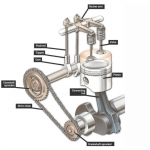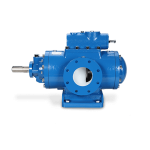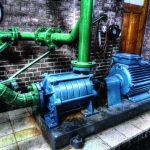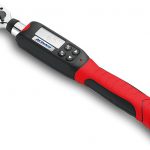Brake horsepower refers to the horsepower at the output shaft of an engine, motor, or turbine., Its value is less than what is indicated on the device due to losses in power from friction. Also, in industry, it is common to refer to brake horsepower as BHP for short, or shaft horsepower.
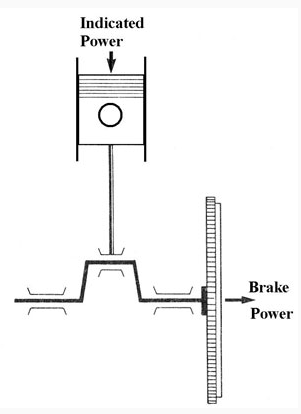
In this article, you will learn the difference between BHP vs WHP, BHP vs torque, and the application of BHP to pumps and compressors.
BHP vs WHP
Wheel horsepower, or WHP, is the amount of power available at the wheels of a vehicle. Moreover, it is less than the BHP of the system, which in turn is less than the engine horsepower. Generally, most applications’ WHP registers around 15% less than the BHP. And the difference could be more when high levels of friction and inefficiencies exist in the transmission. For instance, this is the case with four-wheel drives. To properly understand these concepts, it is important to take a quick look at the power generation and transmission process in a vehicle.
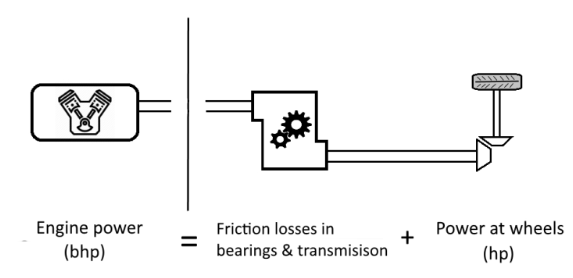
After power generation occurs in the combustion chamber of an engine, it transmits via the pistons, crankshaft, and flywheel. During this process, power losses due to friction and other inefficiencies occur. As a result, the BHP, which is what is obtainable at the flywheel, is much less than the initial power from the combustion chamber. This initial power is the engine horsepower. Furthermore, from the flywheel, the BHP is what is available to transmit via the gear/transmission system and eventually gets to the wheels. Before getting to the wheels, some of this power serves other systems such as the water pump, cooling, alternator, etc. The horsepower at the end that drives the vehicle’s wheels is known as WHP. In addition to the losses that this section highlights, there are environmental factors external to the engine that reduce or increase the avaiable horsepower.
Environmental Factors
The operational environment of the vehicle is very important when considering its power generation. Moreover, changes in environmental conditions affect the amount of horsepower that the engine generates. Below, highlights some of these factors.
- Altitude: The higher you go above the sea level, the less oxygen available. Thus, a vehicle operating on a high altitude has less oxygen, which is critical to combustion and power generation in an engine. As a result, the engine will perform below its power rating.
- Humidity: This has a similar effect as the altitude. Because of the higher the humidity, the less oxygen available in the air. Hence, poorer performance from the engine.
- Temperature: When the temperature is cool, there is less water vapor in the air and more oxygen. So, this results in greater engine efficiency and more horsepower in comparison to hot temperatures with more water vapor in the air. However, in diesel engines, which have a different ignition system, hotter temperatures help to deliver more consistent horsepower.
BHP vs Torque
The BHP and torque are important parameters of a vehicle’s engine. Both measurements occur at the crankshaft or flywheel. As a result, there is a simple relation between BHP vs. torque. It involves the crankshaft speed in RPM as follows:
![]()
In any case, there are several differences between BHP vs. torque as the table below highlights.
| Brake Horsepower | Torque |
| This is the total power output of an engine, as obtainable at the crankshaft. | It is a measure of how much turning force the crankshaft generates. |
| Although a dynamometer can be used to measure it from a crankshaft, it is a derived quantity, dependent on a product of torque and RPM. | Torque is a physical quantity that can be directly measured. |
| It is a more important parameter when considering the speed of a vehicle. | Torque provides a more important parameter when accelerating a vehicle. The more the torque, the better the acceleration. |
| A short-stroke engine provides more power strokes per time and thus more BHP. | An engine can deliver more torque with longer strokes. |
| Retarding the cam timing equates to higher BHP, especially at higher RPM’s. | Advancing the cam timing delivers more low-down torque. |
BHP Applicability to Pumps and Compressors
Although the name ‘brake horsepower’ stems from vehicles, the application of the concept is not for cars only. For example, it is a key parameter when considering pump and compressor systems.
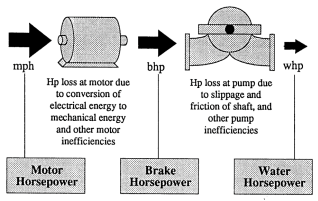
The diagram above highlights the BHP concept for the water pumping process of an electrical pump. First, an electric motor converts electrical energy to mechanical energy. While making this conversion, energy losses occur due to motor inefficiencies. Thus, a reduction in the rated motor horsepower results in a lower value for the brake horsepower at the motor outlet.
Subsequently, the available BHP drives the pump to do work on the water. Due to slippage and friction of the pump shaft, among other inefficiencies, further losses occur. As a result, only a fraction of the BHP will be available to do the actual pumping. This is the wheel horsepower. But in this application, it is common to refer to it as water horsepower. Additionally, the motor horsepower is the equivalent of the engine horsepower in a vehicle.
